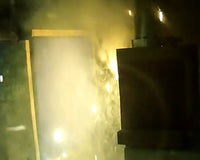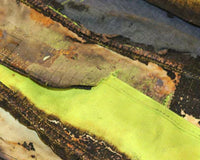An Arc Flash is caused when something obstructs the normal flow of electricity and creates an arc through the air between two phases or from phase to ground.
For those of you who are not up on your electricity terms, picture a bird stretching its wings across two of the power lines... a massive lighting bolt shooting through the bird from line to line... which then leads to an explosion.
Take that same concept and apply it to the motor starter that runs a 30 hp pump in your facility. Except this time, instead of a bird, it’s a mouse, water infiltration, corrosion, dust, loose parts, a tool, a digital multimeter, or your hand. That’s what causes an arc flash.
A definition of Arc Flash:
"An Arc Flash is caused by an accidental short circuit in an electrical phase, either from phase to ground or phase to phase. An Arc Flash is an explosion of oxygen in the air around the phase(s), which creates a really high temperature; enough to melt conductors and other electrical parts. In turn causes an extremely loud bang as the explosion takes place".
Arc Flash Hazards
When working on or near electrical equipment you need to become familiar with the hazards associated with that particular work. You may already have a good understanding of shock hazard but what about arc flash?
First, we need to get our terminology right. We need to focus on arc flash hazards more than arc flash events. This is because one of the fundamentals of a good safety program is identifying hazards.
If you are focused on the “event” then it’s already too late... the arc flash has happened.
A definition of an Arc Flash Hazard:
“A source of possible injury or damage to health associated with the release of energy caused by an electric arc.”
That’s a nice definition but it doesn’t really tell us much.
What you need to take away from this is that an arc flash hazard is any piece of electrical equipment that has the potential to violently explode, sending insane amounts of heat, plasma, light, shrapnel, vapor, shock waves, and molten metal shards in the direction of anyone working close by. That sounds a lot scarier than a release of energy.
And you are probably going to want take a lot of steps to protect you and your team from it.
Protecting You and Your Team from Arc Flash
There's a range of different areas that contribute to the ongoing safety of both yourself and your team against arc flash. Some of the most important include:
Arc Flash Clothing and PPE
This clothing is your most effective protection from an arc flash hazard once the event has occurred. A typical set of Arc Flash Clothing will cover your body head to toe and include:
Learn more about Arc Flash PPE here.
Arc Flash Training
Training is one of the most effective ways to educate your team on the dangers of arc flash hazards.
Learn more about Arc Flash Training here.
Arc Flash Risk Assessments
Risk Assessments are the overall process that identifies hazards, estimates the potential severity of injury or damage to health, estimates the likelihood of occurrence of injury or damage to health, and determines if protective measures are required.
Learn more about Arc Flash Risk Assessments here.
Arc Flash Safety
Arc flash safety is the strategy that you and your organisation use to protect everyone from all arc flash hazards.
Learn more about Arc Flash Safety here.
SKANWEAR® Free Arc Flash Training Support
As well as providing Arc Flash Clothing and PPE we have been providing Arc Flash training workshops, documents, programmes, webinars all in support of our mission #savinglives
Looking for support in rolling out training to your team?
Book a free session with one of our Arc Specialists so we understand your requirements and how best to support your needs.





